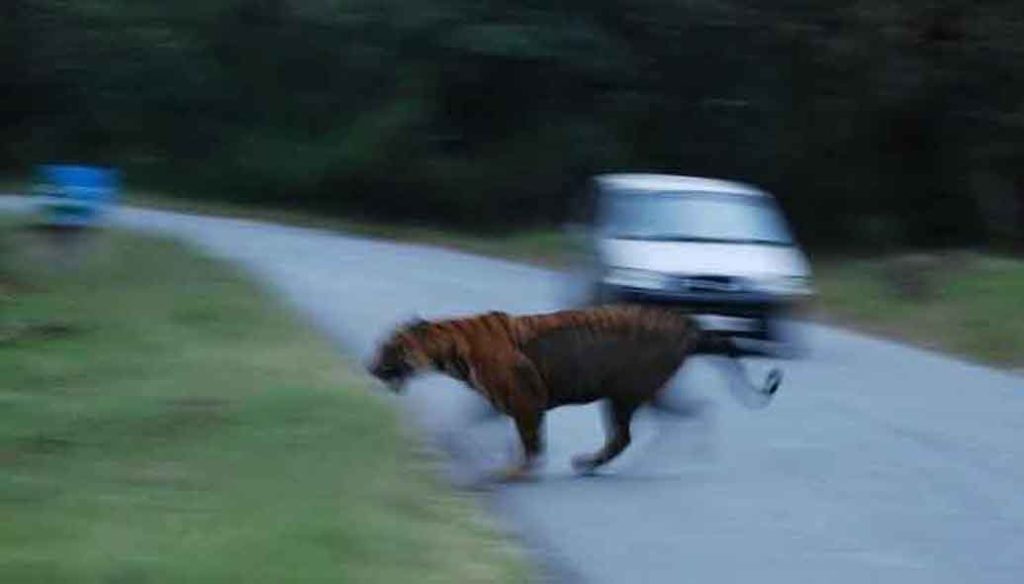The roads cutting into a tiger’s land could be endangering its chances of survival. New research by scientists from the University of Michigan finds that more than 24,000 km of roads built and planned for the future could deepen the big cat’s extinction risk. This includes roads and highways being planned in India and the rest of the tiger nations of the world.
University of Michigan conservation ecologist Neil Carter and his colleagues used a recently developed global roads dataset to calculate the extent and potential impacts of existing and planned road networks across the nearly 12 lakh sq. km, 13-country range of the globally endangered tiger.
Also Read: Supreme Court Stops Road Construction through Rajaji Tiger Reserve
The study showed that road networks are spread out in the entire tiger landscape of 134,000 kilometre at present and they are directly or indirectly responsible for the major threats to the animal. This includes critical threats like – prey population depletion, habitat destruction, and poaching.
Worrying numbers
To understand how roads are impacting the tiger, the researchers measured the road densities for all 76 Tiger Conservation Landscapes of the world, the distance of a reserve or a forest to the nearest road, and the relative mean species abundance in the area.
The scientists also used future expansion plans and the length of the roads that might exist by 2050 in all the tiger nations.
The study revealed the following,
-The current roadways in tiger nations are decreasing the tiger prey base by 20%.
It is easy to understand why. When roads bifurcate a habitat, the tigers and their prey have a smaller space to live. Prey populations such as deer not only have less food, they also have the survival tactic of living with a predator and therefore population remains limited.
–43% of the area where tiger breeding occurs and 57% of the area in Tiger landscapes are within 5 km of a road, proximity that can negatively impact tigers and their prey.
–Nearly 24,000 km of new roads will be built in Tiger Landscapes by 2050.
“Our analysis demonstrates that, overall, tigers face a ubiquitous and mounting threat from road networks across much of their 13-country range,” said U-M’s Carter, an assistant professor at the School for Environment and Sustainability.
“Tiger habitats have declined by 40% since 2006, underscoring the importance of maintaining roadless areas and resisting road expansion in places where tigers still exist, before it is too late. Given that roads will be a pervasive challenge to tiger recovery in the future, we urge decision-makers to make sustainable road development a top priority.”
The researchers stress that already tigers are restricted to specific areas and if the number of concrete roads increases in these areas, it further shrinks the tiger habitat turning them into tiger islands.
Also Read: Uttar Pradesh to Axe 50,000 Trees in Tiger Habitat to Build a Road

Road Block for the National Animal
In 2010, the 13 tiger nations of the world met in St. Petersburg in Russia and declared that they would double the tiger population in their country by 2022. In this respect, only India, Nepal and Bhutan have been able to successfully claim to have raised their tiger numbers. In fact, India announced in 2019 that the number of tigers in the country had reached a population of 2,967 wild cats, thus already doubling the numbers from the 1,411 recorded in 2006.
India has 50 tiger reserves spread across the country so far with an average 1,500 sq. km area. Experts believe an adult male tiger requires about 60-150 sq.km of range whereas a female needs around 20-60 sq.km. If there has been a 30% increase in tiger numbers since 2014 in India, it automatically means there are more tigers in the same space.
Without roaming tigers, none of India’s small reserve populations would be demographically viable in the long run, says Aditya Joshi, head of conservation research at the Wildlife Conservation Trust in this Nature story. Uma Ramakrishnan, an ecologist at the National Centre for Biological Sciences in Bengaluru, says that if infrastructure development in rural areas continues unabated, the genetic diversity of small populations could fall within a century.
And infrastructure development is continuing unabated in India.
According to the Michigan University study, 14,500 km of roads are coming up in the next decade in India. The researchers particularly pinpointed on the Corbett-Sinanadi and Rajaji landscapes for their high road density along with Pench in Madhya Pradesh and Ratnagiri in Maharashtra.
A 2018 study of the Wildlife Conservation Trust on tiger landscapes in Central India and Eastern Ghats also showed that out of a total of 1,697 linear infrastructure projects (roads, railways, canals) that sought forest land, 399 were likely to have a negative impact on tiger corridors.
The Journey of a Thousand Miles…
At present, at least 16 tiger reserves in the country have one or more highways passing through the forests. Like, the Pench Sanctuary and Tiger Reserve which expands in two states of the country namely, Maharashtra and Madhya Pradesh. Apart from the tiger and other animals, the Pench Tiger Reserve shares its forest area with 65 km of the NH44 (National Highway 44). On any given day, over 6,000 trucks, cars, and other vehicles pass through the road.
Also Read: Road Block for Tigers
However, in 2019 when the expansion of the highway was completed, the National Highway Authority of India (NHAI) with constant pressure from conservationists was pushed to try something different. The highway also included five underpasses and four minor bridges in a 37 km stretch to make it easier for the animals to travel. This simple detour from the original plan is what the researchers call a sustainable road development plan. And if it can be done in one park, it can be replicated in other reserves too.
Roads and connectivity are important tools for the economic progress of the country. But in the tiger world, they do not connect – only divide vital habitat. Connecting one species while disconnecting hundreds of others is not how progress should be measured. Successfully connecting people and keeping habitats intact through sustainable road development and innovative ideas like under-bridges are and should be the only way to measure progress.
Featured Image via WWF.Panda.org





